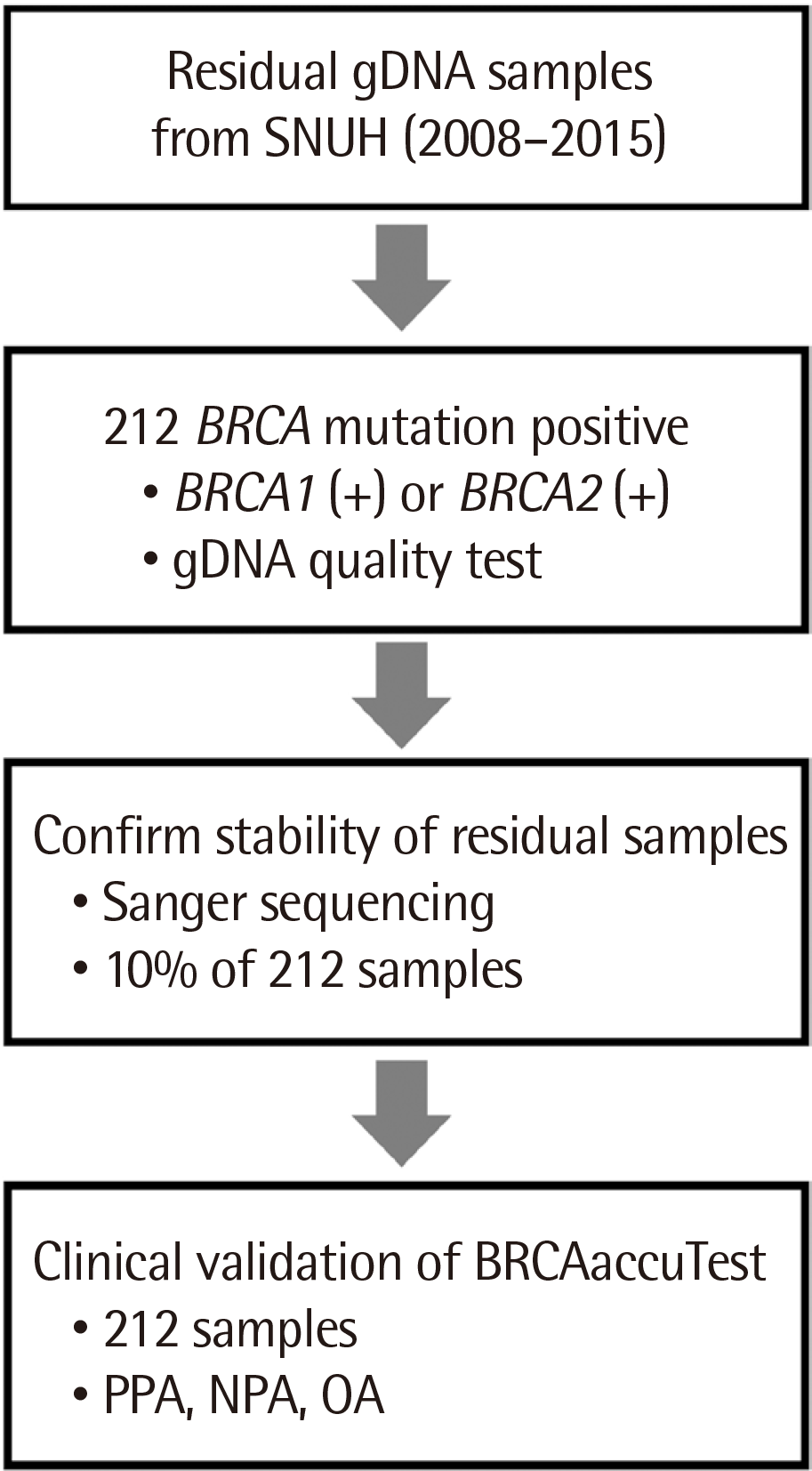1. Heymach J, Krilov L, Alberg A, Baxter N, Chang SM, Corcoran RB, et al. 2018; Clinical Cancer Advances 2018: Annual report on progress against cancer from the American Society of Clinical Oncology. J Clin Oncol. 36:1020–44. DOI:
10.1200/JCO.2017.77.0446. PMID:
29380678.

2. Jung KW, Won YJ, Kong HJ, Lee ES. 2018; Prediction of cancer incidence and mortality in Korea, 2018. Cancer Res Treat. 50:317–23. DOI:
10.4143/crt.2018.142. PMID:
29566480. PMCID:
PMC5912149.

3. Jung KW, Won YJ, Kong HJ, Lee ES. Community of Population-Based Regional Cancer R. 2018; Cancer statistics in Korea: Incidence, mortality, survival, and prevalence in 2015. Cancer Res Treat. 50:303–16. DOI:
10.4143/crt.2018.143. PMID:
29566481. PMCID:
PMC5912151.

4. Park HS, Park SJ, Kim JY, Kim S, Ryu J, Sohn J, et al. 2017; Next-generation sequencing of
BRCA1/2 in breast cancer patients: potential effects on clinical decision-making using rapid, high-accuracy genetic results. Ann Surg Treat Res. 92:331–9. DOI:
10.4174/astr.2017.92.5.331. PMID:
28480178. PMCID:
PMC5416916.
5. Janavičius R. 2010; Founder
BRCA1/2 mutations in the Europe: implications for hereditary breast-ovarian cancer prevention and control. EPMA J. 1:397–412. DOI:
10.1007/s13167-010-0037-y. PMID:
23199084. PMCID:
PMC3405339.
6. Antoniou A, Pharoah PD, Narod S, Risch HA, Eyfjord JE, Hopper JL, et al. 2003; Average risks of breast and ovarian cancer associated with
BRCA1 or
BRCA2 mutations detected in case series unselected for family history: a combined analysis of 22 studies. Am J Hum Genet. 72:1117–30. DOI:
10.1086/375033. PMID:
12677558. PMCID:
PMC1180265.
7. Mavaddat N, Peock S, Frost D, Ellis S, Platte R, Fineberg E, et al. 2013; Cancer risks for
BRCA1 and
BRCA2 mutation carriers: results from prospective analysis of EMBRACE. J Natl Cancer Inst. 105:812–22. DOI:
10.1093/jnci/djt095. PMID:
23628597.
8. D'Argenio V, Esposito MV, Telese A, Precone V, Starnone F, Nunziato M, et al. 2015; The molecular analysis of
BRCA1 and
BRCA2: Next-generation sequencing supersedes conventional approaches. Clin Chim Acta. 446:221–5. DOI:
10.1016/j.cca.2015.03.045. PMID:
25896959.
10. Ruiz A, Llort G, Yagüe C, Baena N, Viñas M, Torra M, et al. 2014; Genetic testing in hereditary breast and ovarian cancer using massive parallel sequencing. Biomed Res Int. 2014:542541. DOI:
10.1155/2014/542541. PMID:
25136594. PMCID:
PMC4098986.

11. Hajian-Tilaki K. 2014; Sample size estimation in diagnostic test studies of biomedical informatics. J Biomed Inform. 48:193–204. DOI:
10.1016/j.jbi.2014.02.013. PMID:
24582925.

12. Joshi NA, Fass JN. Sickle: A sliding-window, adaptive, quality-based trimming tool for FastQ les (Version 1.33) [Software].
https://github.com/najoshi/sickle. Updated on Jul 2014.
14. DePristo MA, Banks E, Poplin R, Garimella KV, Maguire JR, Hartl C, et al. 2011; A framework for variation discovery and genotyping using next-generation DNA sequencing data. Nat Genet. 43:491–8. DOI:
10.1038/ng.806. PMID:
21478889. PMCID:
PMC3083463.

16. Cingolani P, Platts A, Wang le L, Coon M, Nguyen T, Wang L, et al. 2012; A program for annotating and predicting the effects of single nucleotide polymorphisms, SnpEff: SNPs in the genome of Drosophila melanogaster strain w1118; iso-2; iso-3. Fly (Austin). 6:80–92. DOI:
10.4161/fly.19695. PMID:
22728672. PMCID:
PMC3679285.
17. Richards S, Aziz N, Bale S, Bick D, Das S, Gastier-Foster J, et al. 2015; Standards and guidelines for the interpretation of sequence variants: a joint consensus recommendation of the American College of Medical Genetics and Genomics and the Association for Molecular Pathology. Genet Med. 17:405–24. DOI:
10.1038/gim.2015.30. PMID:
25741868. PMCID:
PMC4544753.

18. Kechin A, Khrapov E, Boyarskikh U, Kel A, Filipenko M. 2018;
BRCA-analyzer: Automatic work ow for processing NGS reads of
BRCA1 and
BRCA2 genes. Comput Biol Chem. 77:297–306. DOI:
10.1016/j.compbiolchem.2018.10.012. PMID:
30408727.
19. Ermolenko NA, Boyarskikh UA, Kechin AA, Mazitova AM, Khrapov EA, Petrova VD, et al. 2015; Massive parallel sequencing for diagnostic genetic testing of
BRCA genes--a single center experience. Asian Pac J Cancer Prev. 16:7935–41. DOI:
10.7314/APJCP.2015.16.17.7935. PMID:
26625824.
20. Suryavanshi M, Kumar D, Panigrahi MK, Chowdhary M, Mehta A. 2017; Detection of false positive mutations in
BRCA gene by next generation sequencing. Fam Cancer. 16:311–7. DOI:
10.1007/s10689-016-9955-8. PMID:
27848044.
21. Strom CM, Rivera S, Elzinga C, Angeloni T, Rosenthal SH, Goos-Root D, et al. 2015; Development and validation of a next-generation sequencing assay for
BRCA1 and
BRCA2 variants for the clinical laboratory. PLoS One. 10:e0136419. DOI:
10.1371/journal.pone.0136419. PMID:
26295337. PMCID:
PMC4546651.
22. Capone GL, Putignano AL, Trujillo Saavedra S, Paganini I, Sestini R, Gensini F, et al. 2018; Evaluation of a next-generation sequencing assay for
BRCA1 and
BRCA2 mutation detection. J Mol Diagn. 20:87–94. DOI:
10.1016/j.jmoldx.2017.09.005. PMID:
29061375.






 PDF
PDF Citation
Citation Print
Print



 XML Download
XML Download